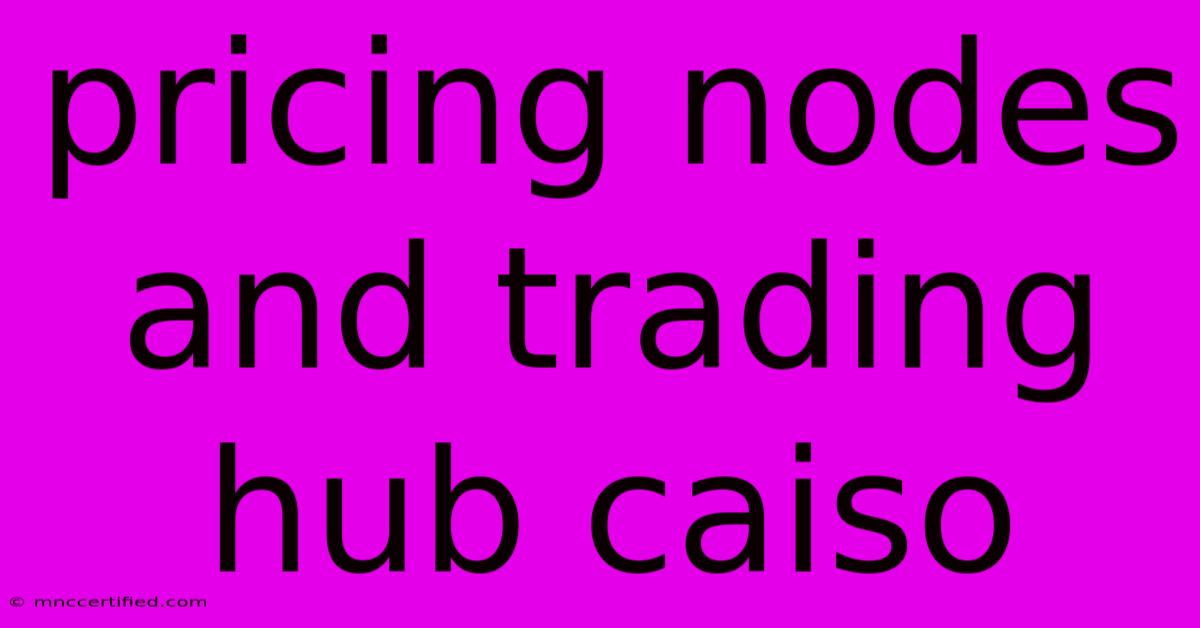Pricing Nodes And Trading Hub Caiso

Table of Contents
Pricing Nodes and Trading Hubs in CAISO: A Comprehensive Guide
The California Independent System Operator (CAISO) manages the bulk electricity market in California, a complex system involving numerous pricing nodes and trading hubs. Understanding how these nodes and hubs function is crucial for anyone involved in California's energy market, from generators and retailers to consumers and policymakers. This guide provides a comprehensive overview of CAISO's pricing nodes and trading hubs, explaining their importance and how they impact electricity prices.
What are CAISO Pricing Nodes?
CAISO's pricing structure is based on a locational marginal pricing (LMP) system. This means that electricity prices vary depending on location. The system divides California into numerous pricing nodes, representing specific points in the transmission network where electricity is metered and priced. The price at each node reflects the supply and demand balance at that particular location, taking into account transmission constraints and congestion.
Factors Affecting Node Prices:
Several factors influence the price at a given pricing node:
- Supply and Demand: The fundamental driver of electricity prices. High demand and low supply push prices up, while the opposite leads to lower prices.
- Transmission Congestion: Constraints on the transmission network can limit the flow of electricity between different areas, causing price discrepancies between nodes. Congestion often leads to higher prices in areas with limited access to generation.
- Generation Mix: The types of power plants supplying electricity at a particular node affect the price. Renewable energy sources like solar and wind power often have lower marginal costs than fossil fuel-based generation, potentially leading to lower prices.
- Real-time Operations: CAISO constantly monitors the power system in real time, adjusting prices based on instantaneous supply and demand conditions. Unexpected outages or surges in demand can drastically impact prices.
Key CAISO Trading Hubs:
While individual pricing nodes provide granular pricing information, CAISO also defines specific trading hubs that represent aggregated price information for larger geographic areas. These hubs simplify trading and provide a more manageable overview of the market. Understanding these hubs is vital for effective market participation.
Examples of Important CAISO Trading Hubs:
- SP15: A significant trading hub located in Southern California, reflecting the price dynamics of a large portion of the region. It often serves as a benchmark price for the area. Understanding SP15 pricing is crucial for those operating in Southern California's electricity market.
- NP15: A major trading hub in Northern California, representing a similar benchmark for that area. Monitoring NP15 pricing is important for market participants in the northern part of the state.
- Zonal Pricing: While not a single "hub" in the same sense as SP15 and NP15, CAISO's zonal pricing system divides the state into larger zones for certain market functions, providing a broader view of price variations across different regions.
It's important to note that the specific locations and designations of CAISO trading hubs may change over time, as the grid evolves and the market adapts. Staying updated on CAISO's official documentation is therefore vital.
The Importance of Understanding Pricing Nodes and Hubs:
For various stakeholders, grasping the nuances of CAISO pricing nodes and hubs is essential for:
- Generators: Optimizing power plant dispatch and maximizing revenue based on locational price differences.
- Retailers: Managing energy procurement costs and effectively pricing electricity to consumers.
- Consumers: Understanding price fluctuations and potentially making informed energy consumption decisions.
- Market Participants: Making sound trading decisions based on accurate price information.
Conclusion:
The CAISO's complex system of pricing nodes and trading hubs underpins the California electricity market. By understanding how these elements interact and influence electricity prices, stakeholders can make informed decisions, optimize operations, and navigate the intricacies of this dynamic market. Continuous monitoring of CAISO's official resources is key to keeping abreast of market changes and maintaining a competitive edge. Regularly checking the CAISO website for updates on pricing nodes and hub definitions is recommended.

Thank you for visiting our website wich cover about Pricing Nodes And Trading Hub Caiso. We hope the information provided has been useful to you. Feel free to contact us if you have any questions or need further assistance. See you next time and dont miss to bookmark.
Featured Posts
-
Compass Offices Opens New Location In Japan
Nov 14, 2024
-
Better Invested Property Management
Nov 14, 2024
-
Heston Blumenthal Opens Up About Bipolar
Nov 14, 2024
-
Razorbacks Land Top Recruit Darius Acuff Jr
Nov 14, 2024
-
Health Insurance Termination Letter
Nov 14, 2024